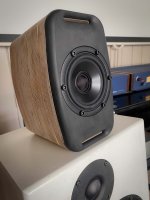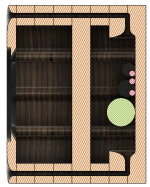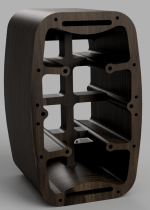Hi, I just thought I'd post this design before I start cutting wood in case anyone can spot any problems.
Based on the the Seas L12RE/XFC coax, I don’t much like the look of the cabinet in the application note so I’ve re-worked the design. I’m happy to go through iterations so doesn’t matter much if I don’t get it right first time.
External dimensions are H 230, W 140, D180mm / H 9, W 5½ , D 7”. The cabinet is made of layered 25mm / 1” ply and the baffle is 12mm / ½” Richlite.
I’ve kept the baffle material thin mostly due to cost but have bracing from front to back. Also the screws to mount the driver go right through the speaker and fit threaded inserts on the back panel.
Volume is 2.3L / 0.08ft3 taking into account x-over components and driver magnet.
I’ve taken the port dimensions from the application note but made 2 ports of ½ area and sightly enlarged the flares.
Fusion 360 doesn’t have a ply material so pics show design in timber.
Based on the the Seas L12RE/XFC coax, I don’t much like the look of the cabinet in the application note so I’ve re-worked the design. I’m happy to go through iterations so doesn’t matter much if I don’t get it right first time.
External dimensions are H 230, W 140, D180mm / H 9, W 5½ , D 7”. The cabinet is made of layered 25mm / 1” ply and the baffle is 12mm / ½” Richlite.
I’ve kept the baffle material thin mostly due to cost but have bracing from front to back. Also the screws to mount the driver go right through the speaker and fit threaded inserts on the back panel.
Volume is 2.3L / 0.08ft3 taking into account x-over components and driver magnet.
I’ve taken the port dimensions from the application note but made 2 ports of ½ area and sightly enlarged the flares.
Fusion 360 doesn’t have a ply material so pics show design in timber.
Attachments
Last edited:
Thanks for taking a look, what do you mean by 'lossy'? I get that the air velocity will be higher... was trying to counter that by enlarging the ports slightly.The two small vent's will be quite lossy, better make it one large port.
I have a pair of 8020s right in front of me... must have given me 'inspiration' 😉. I'm going to start with the application note xover... if the speaker sounds half decent I'm going to go active, so plenty of options.Looks like a Genelec enclosure. Should sound nice if the xover is done right.
I finally got around to making these, still need sanding & finishing but good enough to test.
From 100Hz up they sound great but not a lot below that which I guess is to be expected for a 2.3 litre design but I'm wondering if I can get a little more.
I've not glued the baffles on yet as I want to be able to remove the x-overs if I re-design. They're tightly clamped by the driver but will be a bit leaky... not sure how much difference that would make.
From the measurements below I'm thinking the port tuning is just below 55Hz (dip in the orange line - measurement taken about 10mm from the tweeter) which is lower than the app note which states 63Hz. I didn't bother measuring the input voltage so no indication of sensitivity.
I'm wondering whether re-designing the ports would help, If I make them 10*27mm instead of 6*55mm I could improve the airflow.
Also, I could take the x-overs out of the box which will take the volume up to 2.5L, not sure how much difference that'll make.
Any ideas??


From 100Hz up they sound great but not a lot below that which I guess is to be expected for a 2.3 litre design but I'm wondering if I can get a little more.
I've not glued the baffles on yet as I want to be able to remove the x-overs if I re-design. They're tightly clamped by the driver but will be a bit leaky... not sure how much difference that would make.
From the measurements below I'm thinking the port tuning is just below 55Hz (dip in the orange line - measurement taken about 10mm from the tweeter) which is lower than the app note which states 63Hz. I didn't bother measuring the input voltage so no indication of sensitivity.
I'm wondering whether re-designing the ports would help, If I make them 10*27mm instead of 6*55mm I could improve the airflow.
Also, I could take the x-overs out of the box which will take the volume up to 2.5L, not sure how much difference that'll make.
Any ideas??

If you don't mind trading some peak power output for gain BW, then add some series resistance to flatten it out to a lower Fb. FWIW I used cheap 25 ohm pots to dial in each speaker in room for max overall performance, then replaced them with a resistor 'bank' of tiny resistors to keep SQ high 'on the cheap'.
You should do some more measurements. Impedance curve and tweeter with reversed polarity at 1 meter.
You can not change the baffle in size and form and still expect the same x-over to work.
You need to change the x-over significantly to get something compareable in response like the Seas design. You proved what happens if you change the baffle.
Coax chassis are a very special breed. Do not think they are simpler than a two way, the opposite is right.
That is why some people always write: "Take a good, proven plan for a speaker and stick to it as close as possible. Do not get creative."
I didn't answer your question from post #4: Two ports have more losses than a single port because the air has more wall surface to rub at. The smaller the ports get, the less they work as predicted. You can see more about your actual tuning with the impedance response.
Taking the x-over out of the box is always a good idea if the volume is small and a lot of components (volume) are used. The x-over will reduce the low end significantly in your case. You may place the x-over where you like, near the amp maybe, in some nice enclosure after finding it's final set-up.
A Speakon connector in 4 pole may be a good solution.
You can not change the baffle in size and form and still expect the same x-over to work.
You need to change the x-over significantly to get something compareable in response like the Seas design. You proved what happens if you change the baffle.
Coax chassis are a very special breed. Do not think they are simpler than a two way, the opposite is right.
That is why some people always write: "Take a good, proven plan for a speaker and stick to it as close as possible. Do not get creative."
I didn't answer your question from post #4: Two ports have more losses than a single port because the air has more wall surface to rub at. The smaller the ports get, the less they work as predicted. You can see more about your actual tuning with the impedance response.
Taking the x-over out of the box is always a good idea if the volume is small and a lot of components (volume) are used. The x-over will reduce the low end significantly in your case. You may place the x-over where you like, near the amp maybe, in some nice enclosure after finding it's final set-up.
A Speakon connector in 4 pole may be a good solution.
@GM It's a nice idea I might use in the future but these are pretty low output already so going to see if I can achieve it another way first.
@Turbowatch2 TBH the FR is a lot better than I expected given the changes to the enclosure & baffle, I was using the application note as a starting point rather than expecting a great result first time.
Given I'm looking at the low end response it's well below the crossover point and I'd have thought the baffle is too small to have much impact sub 100Hz - keen to be educated if I'm missing something.
Think I might try re-working the port next, not sure if it's tuned too low or too much internal surface area. If I make the slot 27mm x 10mm then there will be less internal surface area than the Seas design, might loose a bit of length too to bring the port tuning up.
Will take proper measurements soon, just need to order some resistors for the impedance.
@Turbowatch2 TBH the FR is a lot better than I expected given the changes to the enclosure & baffle, I was using the application note as a starting point rather than expecting a great result first time.
Given I'm looking at the low end response it's well below the crossover point and I'd have thought the baffle is too small to have much impact sub 100Hz - keen to be educated if I'm missing something.
Think I might try re-working the port next, not sure if it's tuned too low or too much internal surface area. If I make the slot 27mm x 10mm then there will be less internal surface area than the Seas design, might loose a bit of length too to bring the port tuning up.
Will take proper measurements soon, just need to order some resistors for the impedance.
Probably not... I don't think they're going to be earth shattering but they can probably go a bit lower than I've managed on this first attempt. I just thought they were a manageable size and cost to experiment with plus I've been wanting to experiment with coaxes for a while.is it even possible to get decent bass output from such a small speaker?
As you have two ports, just for measuring, close one or/and both. It will give you an idea how your tune works on this tiny speaker.
This should be a nice speaker if used with one or two small subs. Just make sure to cut it off from the low end. Sound quality should increase dramaticaly
This should be a nice speaker if used with one or two small subs. Just make sure to cut it off from the low end. Sound quality should increase dramaticaly
I finally got around to making these, still need sanding & finishing but good enough to test.
From 100Hz up they sound great but not a lot below that which I guess is to be expected for a 2.3 litre design but I'm wondering if I can get a little more.
In my experience Seas drives sound "Thin" when first played out of the box.
Unless they were loosened up with a bit of playing before installed in your new great looking cabinets I suspect that they low end will change for the better in the next few days
Depends on one's definition, so for me only if BLH loaded.
I was thinking it would do well in Frugel-Horn XL.
dave
Good plan. Hoping to make some more meaningful measurements this weekend.As you have two ports, just for measuring, close one or/and both. It will give you an idea how your tune works on this tiny speaker.
I did a clone of these:https://www.trenner-friedl.com/index.php?menu=product&sprache=de&second=sun,
using it with an naim uniti atom amp, a decent sounding combination. For crossover the application note from seas is quiet useable.
Located in my kitchen it`s perfect for cooking in good mood😉
using it with an naim uniti atom amp, a decent sounding combination. For crossover the application note from seas is quiet useable.
Located in my kitchen it`s perfect for cooking in good mood😉
I came across those when I was reading up on the driver, seem to be well liked by some reviewers. Interesting choice of four tiny ports on the back. I first tried the speakers with some chip amps but it was clear they didn't have the guts to drive it. Sounds much better with a Hypex UCD.
For serious listening I think they're going to need a woofer but perfect for the kitchen!
For serious listening I think they're going to need a woofer but perfect for the kitchen!
- Home
- Loudspeakers
- Multi-Way
- Small Coax Speaker


